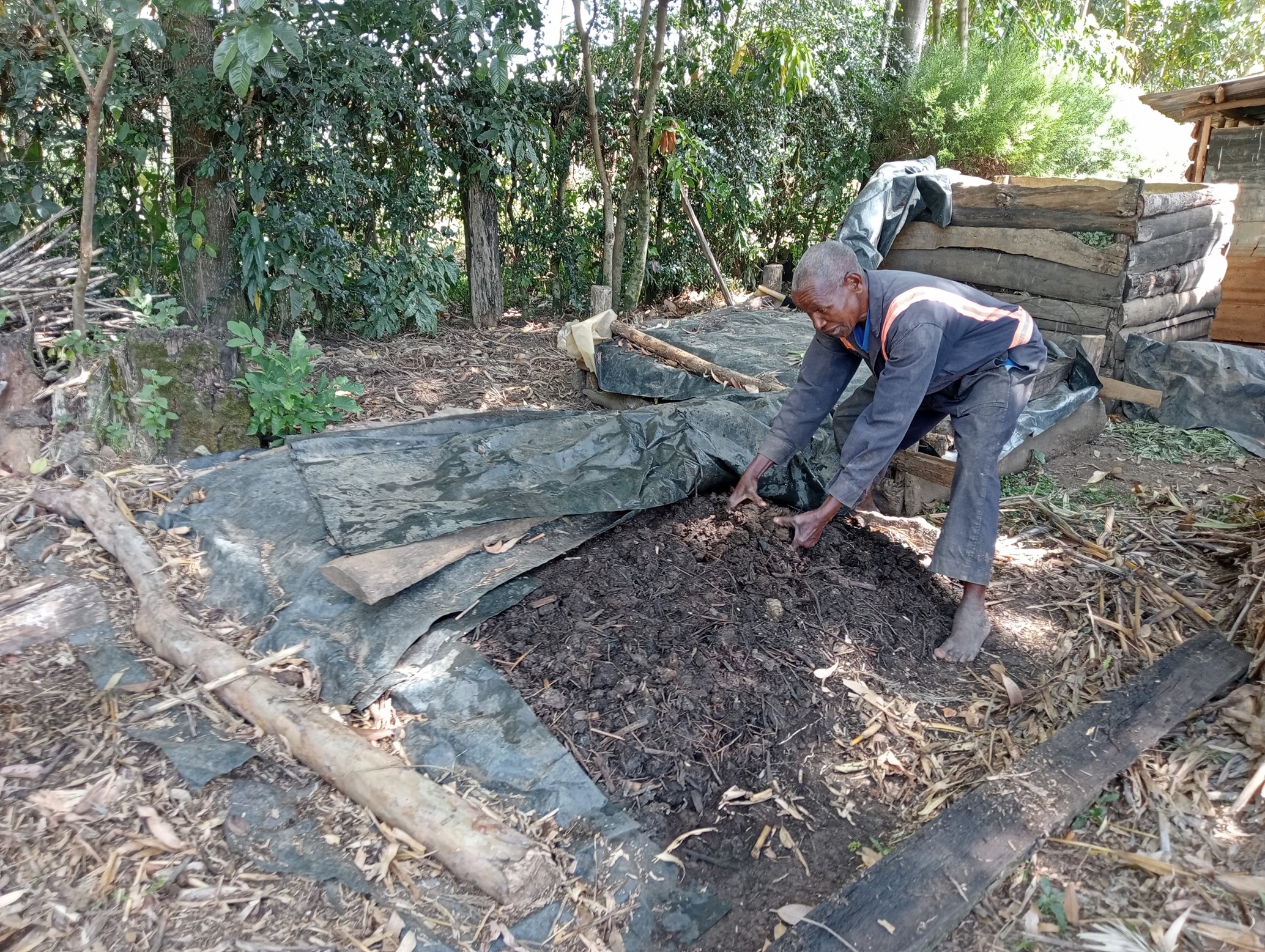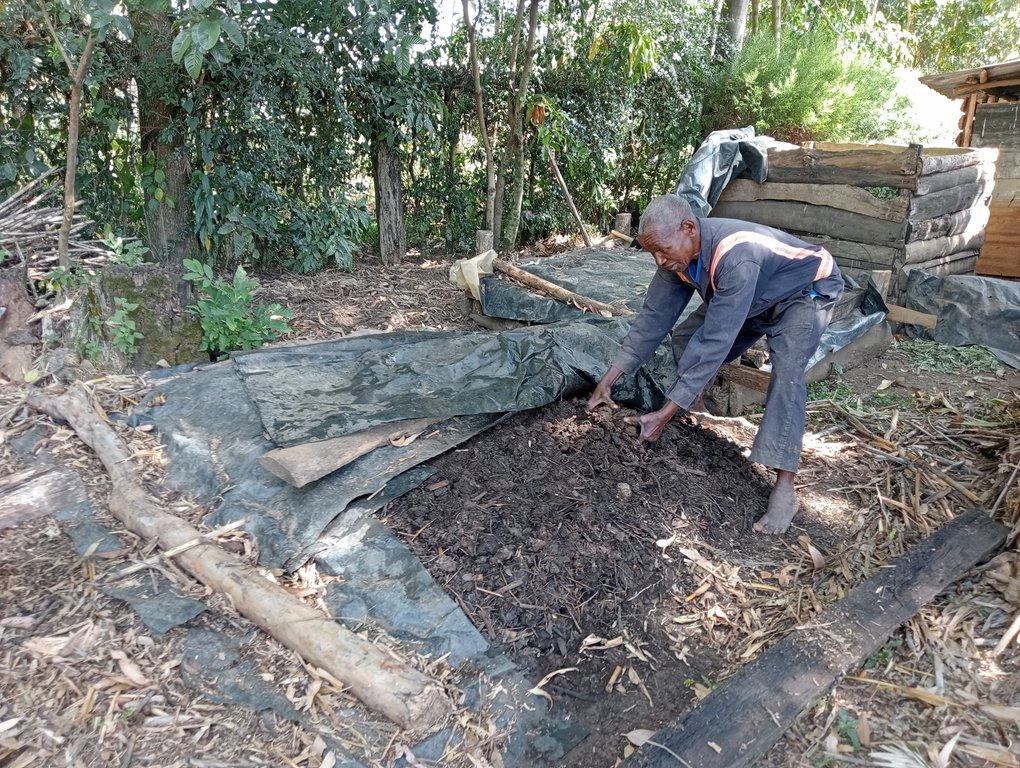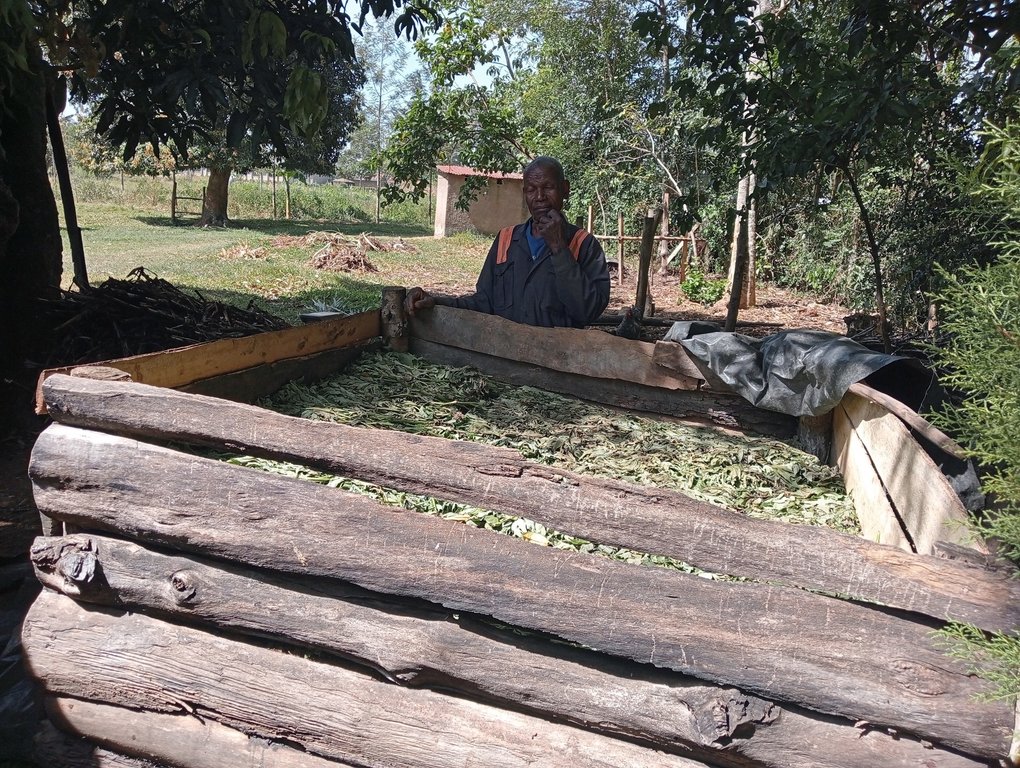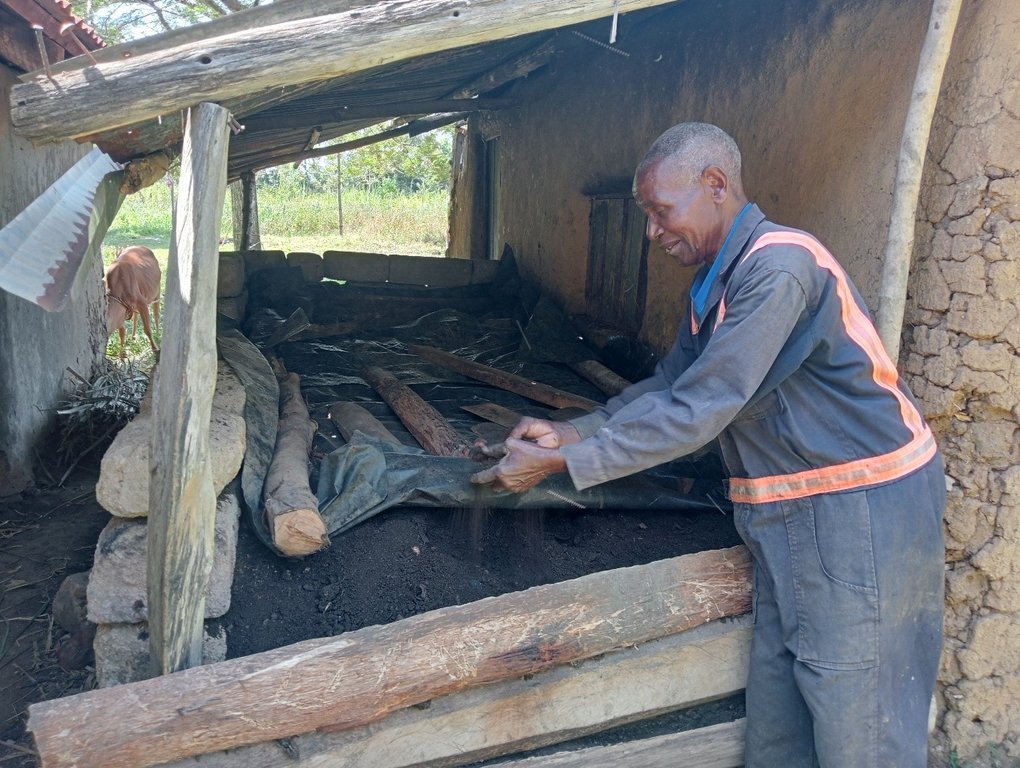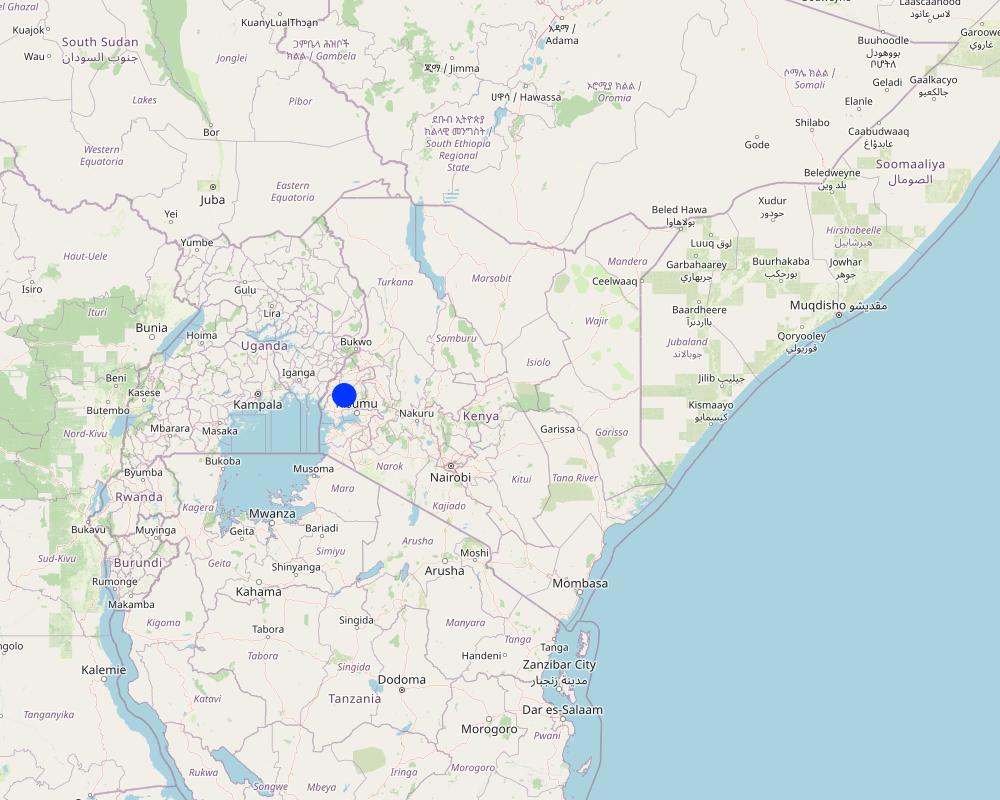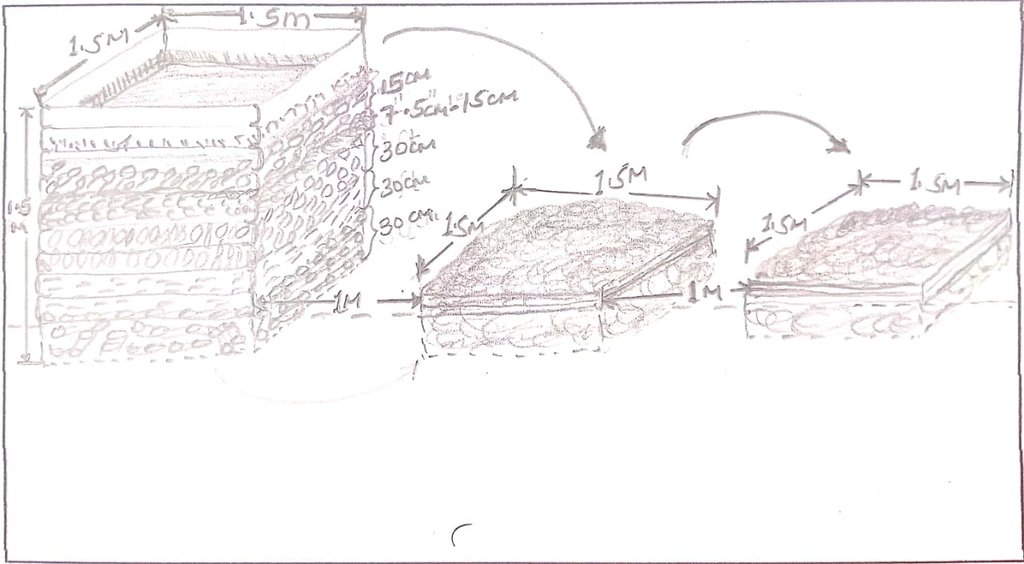Compost for organic waste management and improved crop yields [Kenia]
- Creación:
- Actualización:
- Compilador: William Akwanyi
- Editores: George Onyango, Innocent Faith, Noel Templer, Tabitha Nekesa, Ahmadou Gaye, Siagbé Golli
- Revisores: William Critchley, Rima Mekdaschi Studer, Sally Bunning
Mbolea bora (Kiswahili)
technologies_6648 - Kenia
Visualizar secciones
Expandir todo Colapsar todos1. Información general
1.2 Detalles de contacto de las personas de referencia e instituciones involucradas en la evaluación y la documentación de la Tecnología
Persona(s) de referencia clave
usuario de la tierra:
Anyanga Matthews George
Welthungerhilfe
Kenia
Especialista MST:
Especialista MST:
Nombre del proyecto que financió la documentación/ evaluación de la Tecnología (si fuera relevante)
Soil protection and rehabilitation for food security (ProSo(i)l)Nombre de la(s) institución(es) que facilitaron la documentación/ evaluación de la Tecnología (si fuera relevante)
Deutsche Gesellschaft für Internationale Zusammenarbeit (GIZ)Nombre de la(s) institución(es) que facilitaron la documentación/ evaluación de la Tecnología (si fuera relevante)
Alliance Bioversity and International Center for Tropical Agriculture (Alliance Bioversity-CIAT) - Kenia1.3 Condiciones referidas al uso de datos documentados mediante WOCAT
El compilador y la/s persona(s) de referencia claves aceptan las condiciones acerca del uso de los datos documentados mediante WOCAT:
Sí
1.4 Declaración de la sostenibilidad de la Tecnología descrita
¿La Tecnología aquí descrita resulta problemática en relación a la degradación de la tierra, de tal forma que no puede considerársela una tecnología sostenible para el manejo de la tierra?
No
Comentarios:
Farmers who have implemented the technology have recorded good harvests from their farms. The product of manure has improved their soils.
1.5 Referencia al (los) Cuestionario(s) de Enfoques MST (documentados usando WOCAT)
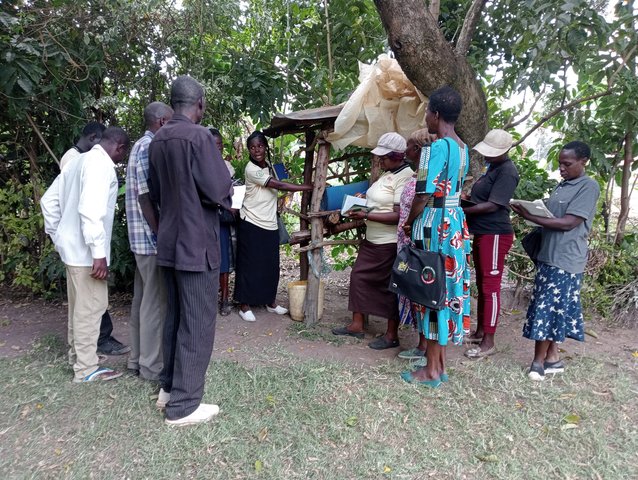
Community Resource Persons (CRP) in agricultural extension [Kenia]
Community Resource Persons (CRP) form a farmer-to-farmer learning approach that bridges the gap in agricultural extension, increases farmers' access to agricultural information (SLM knowledge), and increases the adoption of SLM practices.
- Compilador: William Akwanyi
2. Descripción de la Tecnología MST
2.1 Breve descripción de la Tecnología
Definición de la Tecnología:
Composting with on-farm organic solid waste management improves the soil sustainably and raises crop yields.
2.2 Descripción detallada de la Tecnología
Descripción:
Composting is a natural process of converting organic materials such as plant leaves, and food remains into a nutrient-rich soil-enhancing amendment called compost (if mainly from vegetative matter) or manure (if mainly from animal dung). It involves breaking organic matter down into humus/ compost by aerobic microorganisms - with by-products of water, heat, ammonia (NH3), and carbon dioxide (CO2). Humus is a dark and crumbly natural form of fertilizer applied to the soil to improve crop production. Composting is cost-effective since it can be made from locally available materials such as leaves, plant residues, food remains, cow dung, poultry droppings, animal urine, soil, etc. Composting is thus an on-farm solid waste management measure. When made correctly it can improve carbon sequestration in the soil (compost is carbon-rich) and prevent methane emissions (a greenhouse gas) since methane-producing microbes become inactive in aerobic conditions (in the presence of oxygen).
There are many ways of preparing compost. This method involves three key stages; mixing brown organic materials, such as twigs, and green materials, such as fresh leaves that are nitrogen-rich and moist. In the first stage, brown and green materials are layered, beginning with a 30 cm layer of twigs at the bottom, followed by a 30 cm layer of dry matter, such as maize straw chopped to a maximum of 7.5 cm. This is followed by a 30 cm layer of dry grass and dry leaves covered by a 7.5 cm – 15 cm layer of fresh cow dung. The fresh cow dung is covered by a 15 cm layer of fresh tithonia (an exotic plant) that is completely covered by a layer of ash and sprayed uniformly using 10 litres of animal urine and finally completely covered by a layer of soil or manure. All the above inputs except urine are sprayed with 10 – 20 litres of water. The pile is then completely covered with a black polythene sheet to help absorb heat, prevent the entry of rainwater, and prevent volatilization of nitrogen, i.e., the conversion of ammonium into ammonia gas, and left to decompose for 21 to 30 days.
The second stage involves mixing and transferring all the material except the twigs, to another space. The heap is again completely covered with a black polythene sheet to help absorb heat, prevent rainwater entry, and prevent nitrogen volatilization. It is again left to decompose for another 21 to 30 days. The third stage, like the second stage, involves completely mixing and transferring all the material from the second stage to another space and completely covering the heap with a black polythene sheet to help absorb heat and prevent the entry of rainwater. The contents are allowed to decompose for another 21 to 30 days, after which they are ready-to-use compost. The compost is stored under shade and covered with a black polythene sheet again to prevent nitrogen volatilization.
One heap of compost (first stage: 1.5 m by 1.5 m by 1.5 m) produces about 5 tonnes of ready-to-use compost. Composting takes about 90 days; hence, provided that all inputs are available, a farmer can produce compost 4 times each year from the same heaping point, i.e., about 20 tonnes. Normally, a 0.4-hectare farm requires about 20 tonnes of this compost. However, the amount varies from farm to farm depending on the conditions of the soil and the crop(s) to be grown. It is important that soil testing is done to determine the conditions of the soil to ensure that the compost is being used in the most effective manner.
Compost is carried to the farm on wheelbarrows and in buckets and is applied at the farm during planting time where a handful of compost is applied in the planting hole and mixed with soil before planting. It is again applied around the base of the crop and completely covered with soil. Preparation of compost in conservation agriculture situations could pose the problem of competition for plant material since plant material is used in conservation agriculture to cover the soil. To manage this, a farmer implementing both composting and conservation agriculture may have to acquire plant material for composting from other sources such as purchasing stover from other farmer who are not implementing conservation agriculture. In addition, the farmer could also use hedge trimmings as plant material for composting, especially if the farmer has a live fence.
2.3 Fotografías de la Tecnología
Comentarios generales sobre las fotos:
Composting is a multi-stage process. The inputs/ materials in each stage must be completely covered with a black polythene sheet to help absorb heat, prevent the entry of rainwater, and prevent volatilization of nitrogen. The materials are allowed to decompose for at least 21 days in each stage before they are completely mixed and transferred to the next.
2.5 País/ región/ lugares donde la Tecnología fue aplicada y que se hallan comprendidos por esta evaluación
País:
Kenia
Región/ Estado/ Provincia:
Kakamega County in western Kenya
Especifique más el lugar :
Elang'ata Village, Bulanda Sub-location, Imanga Location, Marama Central Ward, Butere Sub-county
Especifique la difusión de la Tecnología:
- aplicada en puntos específicos/ concentrada en un área pequeña
¿El/los sitio(s) de la Tecnología se ubica(n) en un área de protección permanente?
No
Comentarios:
The farm where the technology is implemented is not in a protected area.
Map
×2.6 Fecha de la implementación
Indique año de implementación:
2018
2.7 Introducción de la Tecnología
Especifique cómo se introdujo la Tecnología:
- mediante la innovación de usuarios de tierras
- como parte de un sistema tradicional (> 50 años)
- mediante proyectos/ intervenciones externas
Comentarios (tipo de proyecto, etc.):
For years, the farmer has been converting farm wastes into manure. However, the Soil Protection and Rehabilitation of Degraded Soil for Food Security (ProSoil) project came in and taught them an improved method of composting that takes a shorter time compared with the traditional method, and prevents loss of nutrients during composting.
3. Clasificación de la Tecnología MST
3.1 Propósito(s) principal(es) de la Tecnología MST
- mejorar la producción
- reducir, prevenir, restaurar la degradación de la tierra
- adaptarse al cambio climático/ extremos climáticos y sus impactos
- mitigar cambio climático y sus impactos
- crear impacto económico benéfico
3.2 Tipo(s) actuales de uso de la tierra donde se aplica la Tecnología
Mezcla de tipos de uso de tierras dentro de la misma unidad de tierras: :
Sí
Especifique el uso combinado de tierras (cultivos/ pastoreo/ árboles):
- Agro-silvopastoralismo

Tierras cultivadas
- Cosecha anual
- Cultivos perennes (no leñosos)
- Cosecha de árboles y arbustos
Cosechas anuales - Especifique cultivos:
- cultivos para forraje - pastos
- cereales - maíz
- vegetales - otros
- leguminosas y legumbres - frijoles
- cultivos de raíces/ tubérculos - mandioca
Sistema anual de cultivo:
Maíz/sorgo/ mijo en intercultivo con legumbres
Cultivos perennes (no maderables) - Especifique cultivos:
- banana/plátano/abacá
Cultivos de matorrales y arbustos - Especifique cultivos:
- avocado
- frutas, otros
- mango, mangostán, guayaba
- papaya
Número de temporadas de cultivo por año:
- 2
Especifique:
Long and short rain seasons
¿Se practica el intercultivo?
Sí
Si respondió que sí, especifique qué cultivos son intercultivados:
Maize and beans
¿Se practica la rotación de cultivos?
Sí
Si fuera el caso, especifique :
Some sections of the farm are left fallow during the short rains to allow for soil regeneration.

Tierra de pastoreo
Pastoreo intensivo/ producción de forraje:
- Cortar y llevar/ cero pastoreo
- Pastoreo mejorado
Tipo de animal:
- ganado - lechero
- cattle - dairy and beef (e.g. zebu)
- aves de corral
¿Se practica el manejo integrado de cultivos - ganado?
Sí
Si fuera el caso, especifique :
Cattle dung and poultry droppings are used as inputs in composting. Compost is applied on soil where livestock fodder is planted.
Productos y servicios:
- economic security, investment prestige
- leche
- manure as fertilizer/ energy production
- huevos
- carne
Especies:
ganado - lechero
Conteo:
2
Especies:
cattle - dairy and beef (e.g. zebu)
Conteo:
3
Especies:
aves de corral
Conteo:
10
Comentarios:
There are assorted trees on the farm, and these provide litter which is an input in composting.
3.3 ¿Cambió el uso de tierras debido a la implementación de la Tecnología?
¿Cambió el uso de tierras debido a la implementación de la Tecnología?
- No (Continúe con la pregunta 3.4)
3.4 Provisión de agua
Provisión de agua para la tierra donde se aplica la Tecnología:
- de secano
Comentarios:
Crops are planted only during the rainy seasons since there is no irrigation.
3.5 Grupo MST al que pertenece la Tecnología
- manejo de agricultura—ganadería integrada
- manejo integrado de la fertilidad del suelo
- manejo de desperdicios/ manejo de aguas residuales
3.6 Medidas MST que componen la Tecnología

medidas agronómicas
- A2: materia orgánica/ fertilidad del suelo
- A6: Manejo de residuos
A6: Especifique manejo de residuos:
A 6.3: recogido
Comentarios:
Plant residues, especially leaves and soft branches are collected and used as input in composting. However, some plant matter is retained in the farm to naturally decompose and turn into manure at the farm. The farmer does not collect plant residues from protected areas. He has planted tithonia at some sections of the hedges at his farm; this provides the main source of tithonia. However, he sometimes harvests tithonia from his neighbours' hedges upon request.
3.7 Principales tipos de degradación de la tierra encarados con la Tecnología

deterioro químico del suelo
- Cn: reducción de la fertilidad y contenido reducido de la materia orgánica del suelo (no ocasionados por la erosión)
- Ca: acidificación
- Cp: contaminación del suelo
Comentarios:
Covering of compost-making materials and the final compost reduces loss of nitrogen through volatilization of ammonium into ammonia gas. Compost raises the pH of soils when applied at the farm. Compost contains living organisms (bacteria and fungi) that degrade soil pollutants into non-toxic substances.
3.8 Prevención, reducción o restauración de la degradación de la tierra
Especifique la meta de la Tecnología con relación a la degradación de la tierra:
- prevenir la degradación de la tierra
- restaurar/ rehabilitar tierra severamente degradada
Comentarios:
Compost improves soil structure and porosity. Compost balances soil pH.
4. Especificaciones técnicas, actividades de implementación, insumos y costos
4.1 Dibujo técnico de la Tecnología
Especificaciones técnicas (relacionadas al dibujo técnico):
Stage 1: about 30 cm deep under the ground, 1.5 m long by 1.5 m wide by 1.5 m high, including the 30 cm below the ground. Constructed using timber off-cuts (locally known as magogo) supported on posts at corners using nails. From bottom: 30 cm of twigs to extend some few inches above the ground to allow air circulation, 30 cm of dry matter e.g., maize straw chopped to 7.5 cm maximum, 30 cm dry grass and leaves, 7.5 cm - 15 cm layer of fresh cow dung, 15 cm layer of fresh tithonia, layer of ash, layer of soil or manure, black polythene sheet cover.
Stages 2 and 3: about 1-ft deep under the ground, 1.5 m long by 1.5 m wide, height depends on the volume of the material.
Allow space of no more than 1 m from one stage to the other for easy of mixing and transfer of materials from one stage to the next.
Autor:
William Onura
Fecha:
26/01/2023
4.2 Información general sobre el cálculo de insumos y costos
Especifique cómo se calcularon los costos e insumos:
- por unidad de Tecnología
Especifique unidad:
Heap of compost
Especifique las dimensiones de la unidad (si fuera relevante):
1.5 m by 1.5 m by 1.5 m
otra / moneda nacional (especifique):
KES
Si fuera relevante, indique la tasa de cambio de dólares americanos a la moneda local (ej. 1 U$ = 79.9 Reales Brasileros): 1 U$ =:
122,95
Indique el costo promedio del salario de trabajo contratado por día:
200
4.3 Actividades de establecimiento
| Actividad | Momento (estación) | |
|---|---|---|
| 1. | Digging of pits | At least 3 months before planting time |
| 2. | Framework construction with off cuts | At least 3 months before planting time |
| 3. | Filling stage one with inputs | At least 3 months before planting time |
Comentarios:
Composting takes about 3 months; hence, the farmer should have the structures for composting at least 3 months before the planting time. A farmer can produce 20 tonnes of compost from 1 heap (1.5 m by 1.5 m by 1.5 m).
4.4 Costos e insumos necesarios para el establecimiento
| Especifique insumo | Unidad | Cantidad | Costos por unidad | Costos totales por insumo | % de los costos cubiertos por los usuarios de las tierras | |
|---|---|---|---|---|---|---|
| Mano de obra | Framework construction | Man-days | 2,0 | 200,0 | 400,0 | 100,0 |
| Mano de obra | Filling inputs | Man-days | 1,0 | 200,0 | 200,0 | 100,0 |
| Equipo | Jembe (hoe) | No. | 1,0 | 80,0 | 80,0 | |
| Equipo | Spade | No. | 1,0 | 90,0 | 90,0 | |
| Equipo | Fork hoe | No. | 1,0 | 70,0 | 70,0 | |
| Equipo | Wheelbarrow | No. | 1,0 | 800,0 | 800,0 | |
| Equipo | Hummer | No. | 1,0 | 100,0 | 100,0 | 100,0 |
| Equipo | Handsaw | No. | 1,0 | 200,0 | 200,0 | 100,0 |
| Material para plantas | Twigs | Wheelbarrow | 2,0 | 100,0 | 200,0 | 100,0 |
| Material para plantas | Dry matter | Wheelbarrow | 6,0 | 50,0 | 300,0 | 100,0 |
| Material para plantas | Dry grass and leaves | 90 Kg sack | 3,0 | 50,0 | 150,0 | 100,0 |
| Material para plantas | Fresh tithonia | 90 Kg sack | 3,0 | 50,0 | 150,0 | 100,0 |
| Fertilizantes y biocidas | Ash | 90 Kg sack | 0,4 | 200,0 | 80,0 | 100,0 |
| Fertilizantes y biocidas | Animal urine | 10 litre container | 1,0 | 125,0 | 125,0 | 100,0 |
| Fertilizantes y biocidas | Soil or manure | Wheelbarrow | 1,0 | 300,0 | 300,0 | 100,0 |
| Fertilizantes y biocidas | Fresh cow dung | Wheelbarrow | 3,0 | 200,0 | 600,0 | 100,0 |
| Material de construcción | Timber off-cuts | Pieces | 16,0 | 100,0 | 1600,0 | 100,0 |
| Material de construcción | Wooden posts | Pieces | 4,0 | 50,0 | 200,0 | 100,0 |
| Material de construcción | Nails (assorted sizes) | Kgs | 3,0 | 200,0 | 600,0 | 100,0 |
| Otros | Water | 20 litres container | 4,0 | 5,0 | 20,0 | 100,0 |
| Costos totales para establecer la Tecnología | 6265,0 | |||||
| Costos totales para establecer la Tecnología en USD | 50,96 | |||||
Si el usuario de la tierra no cubrió el 100% de los costos, indique quién financió el resto del costo:
ProSoil project
Comentarios:
The ProSoil project through Welthungerhilfe provided hoes, fork hoes, wheelbarrows, and spades to the farmers. The costs of these implements are KES 400/- for a hoe, KES 350/- for a fork hoe, KES 4,000/- for a wheelbarrow, KES 450/- for a spade, KES 500/- for a hummer, and KES 1,000/- for a handsaw. It is assumed that the farmer will be able to use the hoe, fork hoe, spade, hummer, and handsaw over a period of 5 years, and a wheelbarrow over a period of 10 years before these implements will have depreciated to a point where they will not be useable. The cost is thus spread over the years when the farmer will be able to use the implement.
4.5 Actividades de establecimiento/ recurrentes
| Actividad | Momento/ frequencia | |
|---|---|---|
| 1. | Turning at each stage | 21 - 30 days after start of each stage |
| 2. | Refilling at the first stage | At turning from the first stage |
| 3. | Distribution to the farm | When planting and at first weeding (i.e., 3rd week after planting) |
Comentarios:
Turning involves complete mixing and transfer of the inputs from one stage to the next. Compost is applied at the farm during planting time where a handful of compost is applied in the planting hole and mixed with soil before planting. It is again applied around the base of the crop and completely covered with soil.
4.6 Costos e insumos necesarios para actividades de mantenimiento/ recurrentes (por año)
| Especifique insumo | Unidad | Cantidad | Costos por unidad | Costos totales por insumo | % de los costos cubiertos por los usuarios de las tierras | |
|---|---|---|---|---|---|---|
| Mano de obra | Complete mixing and turning from stage one to stage two and from stage two to stage three | Man-days | 4,0 | 200,0 | 800,0 | 100,0 |
| Mano de obra | Refilling with new materials at the first stage | Man-days | 1,0 | 200,0 | 200,0 | 100,0 |
| Mano de obra | Transfer to storage | Man-days | 2,0 | 200,0 | 400,0 | 100,0 |
| Mano de obra | Distribution to the farm | Man-days | 2,0 | 200,0 | 400,0 | 100,0 |
| Equipo | Hoe | No. | 1,0 | 80,0 | 80,0 | |
| Equipo | Fork hoe | No. | 1,0 | 90,0 | 90,0 | |
| Equipo | Spade | No. | 1,0 | 70,0 | 70,0 | |
| Equipo | Wheelbarrow | No. | 1,0 | 400,0 | 400,0 | |
| Material para plantas | Dry matter | Wheelbarrow | 6,0 | 50,0 | 300,0 | 100,0 |
| Material para plantas | Dry grass and leaves | 90Kg sack | 3,0 | 50,0 | 150,0 | 100,0 |
| Material para plantas | Fresh tithonia | 90Kg sack | 3,0 | 50,0 | 150,0 | 100,0 |
| Fertilizantes y biocidas | Ash | 90 Kg sack | 0,4 | 200,0 | 80,0 | 100,0 |
| Fertilizantes y biocidas | Animal urine | 10 litre container | 1,0 | 125,0 | 125,0 | 100,0 |
| Fertilizantes y biocidas | Soil or manure | Wheelbarrow | 1,0 | 300,0 | 300,0 | 100,0 |
| Fertilizantes y biocidas | Fresh cowdung | Wheelbarrow | 3,0 | 200,0 | 600,0 | 100,0 |
| Otros | Water | 20 litres container | 4,0 | 5,0 | 20,0 | 100,0 |
| Indique los costos totales para mantenecer la Tecnología | 4165,0 | |||||
| Costos totales para mantener la Tecnología en USD | 33,88 | |||||
Si el usuario de la tierra no cubrió el 100% de los costos, indique quién financió el resto del costo:
ProSoil project
Comentarios:
The hoes, fork hoes, wheelbarrows, and spades provided by the ProSoil project through Welthungerhilfe are fixed assets and are used for years by the farmer before they can wear out. The farmer can use these implements for other work at the farm. The costs of these implements are KES 400/- for a hoe, KES 350/- for a fork hoe, KES 4,000/- for a wheelbarrow, and KES 450/- for a spade. It is assumed that the farmer will be able to use the hoe, fork hoe, and spade over a period of 5 years, and a wheelbarrow over a period of 10 years before these implements will have depreciated to a point where they will not be useable. The cost is thus spread over the years when the farmer will be able to use the implement. The twigs are reused during the refilling process since they take long to decompose.
4.7 Factores más determinantes que afectan los costos:
Describa los factores más determinantes que afectan los costos:
Rate of man-days vary from one place to another. It is not easy to attach monetary value to some of the input e.g., animal urine, cow dung, and water.
Exchange rate for January 2023, source: European Commission/ InfoEuro online at https://commission.europa.eu/funding-tenders/procedures-guidelines-tenders/information-contractors-and-beneficiaries/exchange-rate-inforeuro_en
5. Entorno natural y humano
5.1 Clima
Lluvia anual
- < 250 mm
- 251-500 mm
- 501-750 mm
- 751-1,000 mm
- 1,001-1,500 mm
- 1,501-2,000 mm
- 2,001-3,000 mm
- 3,001-4,000 mm
- > 4,000 mm
Especificaciones/ comentarios sobre la cantidad de lluvia:
Monthly rainfall variability is high with some months such as January recording less than 5 mm of total rainfall.
Indique el nombre de la estación metereológica de referencia considerada:
Kakamega Meteorological Station
Zona agroclimática
- húmeda
The climate in the area favours most agricultural activities.
5.2 Topografía
Pendientes en promedio:
- plana (0-2 %)
- ligera (3-5%)
- moderada (6-10%)
- ondulada (11-15%)
- accidentada (16-30%)
- empinada (31-60%)
- muy empinada (>60%)
Formaciones telúricas:
- meseta/ planicies
- cordilleras
- laderas montañosas
- laderas de cerro
- pies de monte
- fondo del valle
Zona altitudinal:
- 0-100 m s.n.m.
- 101-500 m s.n.m.
- 501-1,000 m s.n.m
- 1,001-1,500 m s.n.m
- 1,501-2,000 m s.n.m
- 2,001-2,500 m s.n.m
- 2,501-3,000 m s.n.m
- 3,001-4,000 m s.n.m
- > 4,000 m s.n.m
Indique si la Tecnología se aplica específicamente en:
- no relevante
Comentarios y especificaciones adicionales sobre topografía :
The farm is located at an area that is higher in altitude compared to other areas in the larger area. The average altitude for the area is 1,350m above sea level but the farm is at 1,401m above sea level.
5.3 Suelos
Profundidad promedio del suelo:
- muy superficial (0-20 cm)
- superficial (21-50 cm)
- moderadamente profunda (51-80 cm)
- profunda (81-120 cm)
- muy profunda (>120 cm)
Textura del suelo (capa arable):
- mediana (limosa)
Textura del suelo (> 20 cm debajo de la superficie):
- áspera/ ligera (arenosa)
Materia orgánica de capa arable:
- media (1-3%)
Si se halla disponible, adjunte una descripción completa de los suelos o especifique la información disponible, por ej., tipo de suelo, pH/ acidez de suelo, capacidad de intercambio catiónico, nitrógeno, salinidad, etc. :
Soil pH of most farms in the area ranges from moderately acid (5.50) to moderately alkaline (7.80).
5.4 Disponibilidad y calidad de agua
Agua subterránea:
5-50 m
Disponibilidad de aguas superficiales:
bueno
Calidad de agua (sin tratar):
agua potable de mala calidad (requiere tratamiento)
La calidad de agua se refiere a:
agua subterránea y superficial
¿La salinidad del agua es un problema?
No
¿Se está llevando a cabo la inundación del área? :
No
Comentarios y especificaciones adicionales sobre calidad y cantidad de agua:
There are several boreholes in the area and according to interviews with some borehole owners, the depts are not more than 50 metres.
5.5 Biodiversidad
Diversidad de especies:
- mediana
Diversidad de hábitats:
- mediana
Comentarios y especificaciones adicionales sobre biodiversidad:
The area has high agrobiodiversity since most farms are under crops and trees.
5.6 Las características de los usuarios de la tierra que aplican la Tecnología
Sedentario o nómada:
- Semi-nómada
Orientación del mercado del sistema de producción:
- mixta (subsistencia/ comercial)
Ingresos no agrarios:
- > 50% de todo el ingreso
Nivel relativo de riqueza:
- promedio
Individuos o grupos:
- individual/ doméstico
Nivel de mecanización:
- trabajo manual
- tracción animal
Género:
- mujeres
- hombres
Edad de los usuarios de la tierra:
- jóvenes
- personas de mediana edad
- ancianos
Indique otras características relevantes de los usuarios de las tierras:
The farmer uses the land together with his other family members.
5.7 Área promedio de la tierra usada por usuarios de tierra que aplican la Tecnología
- < 0.5 ha
- 0.5-1 ha
- 1-2 ha
- 2-5 ha
- 5-15 ha
- 15-50 ha
- 50-100 ha
- 100-500 ha
- 500-1,000 ha
- 1,000-10,000 ha
- > 10,000 ha
¿Esto se considera de pequeña, mediana o gran escala (refiriéndose al contexto local)?
- escala mediana
Comentarios:
Farmers with more than 2 ha in the area are considered to have large pieces of land since there is high level of land fragmentation in the area.
5.8 Tenencia de tierra, uso de tierra y derechos de uso de agua
Tenencia de tierra:
- individual, sin título
- individual, con título
Derechos de uso de tierra:
- arrendamiento
- individual
Derechos de uso de agua:
- acceso abierto (no organizado)
- individual
¿Los derechos del uso de la tierra se basan en un sistema legal tradicional?
No
Especifique:
Each landowner has full control of the way he/ she wants to use his/ her land.
Comentarios:
The farmer has an official ownership title for his piece of land. He also leases other people's pieces of land for farming. Water in the streams and springs is freely accessed without restrictions. There is a borehole in the neighbourhood, and the managers of this borehole have set rules for accessing the water thereat.
5.9 Acceso a servicios e infraestructura
salud:
- pobre
- moderado
- bueno
educación:
- pobre
- moderado
- bueno
asistencia técnica:
- pobre
- moderado
- bueno
empleo (ej. fuera de la granja):
- pobre
- moderado
- bueno
mercados:
- pobre
- moderado
- bueno
energía:
- pobre
- moderado
- bueno
caminos y transporte:
- pobre
- moderado
- bueno
agua potable y saneamiento:
- pobre
- moderado
- bueno
servicios financieros:
- pobre
- moderado
- bueno
Comentarios:
The above rating varies from one village to the other.
6. Impactos y comentarios para concluir
6.1 Impactos in situ demostrados por la Tecnología
Impactos socioeconómicos
Producción
producción de cultivo
Cantidad antes de MST:
Less than 4
Cantidad luego de MST:
More than 8
Comentarios/ especifique:
Quantity refers to the number of 90 Kg bags of maize produced per acre. Based on measurement by the farmer.
calidad de cultivo
Comentarios/ especifique:
Not easy to quantify. The crops do better compared to how they could do in the past, yet he does not use inorganic fertilizers. Based on estimation by the farmer.
producción de forraje
Cantidad antes de MST:
2
Cantidad luego de MST:
3 - 4
Comentarios/ especifique:
Quantity refers to harvesting cycles for nappier grass from the same farm. He applies compost on the pieces of land where he has grown fodder. The fodder does better than how it used to do before when he was not applying compost.
calidad de forraje
Comentarios/ especifique:
He applies compost on the pieces of land where he has grown fodder.
producción animal
Cantidad antes de MST:
1 - 3
Cantidad luego de MST:
3 - 10
Comentarios/ especifique:
Quantity refers to the amount of milk in litres from one cow. He gets more milk from his cows as compared to what he used to get before the SLM since applying compost on the pieces of land where he has grown fodder makes the fodder to grow faster. Milk production is often at the peak during early lactation months.
riesgo de fracaso de producción
Cantidad antes de MST:
Over 50
Cantidad luego de MST:
Less than 10
Comentarios/ especifique:
Quantity refers to the percentage probability of the crop failing to do well. Quote from the farmer, '... it was 50 50 getting any produce before I started using compost ...' meaning that there was high chance that the crop could fail due to poor soils. Compost is a rich source of organic matter; hence, ensure sustainable agricultural production.
Ingreso y costos
gastos en insumos agrícolas
Cantidad antes de MST:
Over 5,000
Cantidad luego de MST:
0
Comentarios/ especifique:
Quantity refers to the amount of money in Kenya shillings spend on inorganic fertilizers in a season. The farmers no longer spend money inorganic fertilizers.
ingreso agrario
Cantidad antes de MST:
Less than 2,000
Cantidad luego de MST:
20,000
Comentarios/ especifique:
Quantity refers to the amount of money in Kenya shillings received from the sale of farm produce, including compost in a year. The farmer is able to sell surplus crop and animal products as a result of bumper harvest due to the use of compost on his farm.
diversidad de fuentes de ingreso
Cantidad antes de MST:
1 - 3
Cantidad luego de MST:
More than 3
Comentarios/ especifique:
Quantity refers to household income sources, including sale of surplus farm produce and compost. The farmer is able to sell surplus crop and animal products, and other on-farm products such and compost.
carga de trabajo
Cantidad antes de MST:
Over 5
Cantidad luego de MST:
Less than 1
Comentarios/ especifique:
Quantity refers to the number of hours that the farmer can be free in any working day. A lot of work is involved in the preparation and maintenance of compost in order to achieve the desired results.
Impactos socioculturales
seguridad alimentaria/ autosuficiencia
Cantidad antes de MST:
About 3 months of purchasing maize
Cantidad luego de MST:
No months when there is total lack of food in the house
Comentarios/ especifique:
Quantity refers to the number of months in a year when there is total lack of food in the house, and the farmer has to buy all the food required in the house. The soils at the farm have been enhanced; hence, the farmer grows a variety of crops. Food is available in the household to sustain the family from one harvest to the next.
MST/ conocimiento de la degradación de la tierra
Cantidad antes de MST:
10%
Cantidad luego de MST:
Over 90%
Comentarios/ especifique:
Quantity refers to the estimated percentage of knowledge in SLM/ land management. Not only is the farmer equipped with skills on how to make compost but also with skills in other SLM technologies such as vermicomposting.
Impactos ecológicos
Suelo
humedad del suelo
Cantidad antes de MST:
Less than 10
Cantidad luego de MST:
20 or more
Comentarios/ especifique:
Quantity refers to the farmer's estimated soil moisture content during the dry season when soil moisture challenges are expected to be high.
cubierta del suelo
Cantidad antes de MST:
30 - 50
Cantidad luego de MST:
60 - 80
Comentarios/ especifique:
Quantity refers to the farmer's estimated percentage soil cover at the farm.
materia orgánica debajo del suelo C
Comentarios/ especifique:
Quantity refers to the farmer's estimated percentage of organic matter at the farm. Based on estimation by the farmer.
Biodiversidad: vegetación, animales
Cubierta vegetal
Cantidad antes de MST:
30 - 50
Cantidad luego de MST:
60 - 80
Comentarios/ especifique:
Quantity refers to the farmer's estimated percentage vegetation cover at the farm.
diversidad vegetal
Cantidad antes de MST:
About 3
Cantidad luego de MST:
More than 5
Comentarios/ especifique:
Quantity refers to the number of plants (crops) that the farmer establishes at the farm.
especies benéficas
Comentarios/ especifique:
Not easy to quantify but the number of earthworms in the farm and bees visiting the farm to look for nectar has increased.
diversidad de hábitats
Comentarios/ especifique:
Not easy to quantify but the number of earthworms in the farm has increased which is an indication of increased habitats for different animals at the farm.
Especifique la evaluación de los impactos en el sitio (mediciones):
No recorded data is available for reference. All are estimates based on the farmer's explanation or as given by him.
6.2 Impactos fuera del sitio demostrados por la Tecnología
daño a campos de vecinos
Cantidad antes de MST:
80
Cantidad luego de MST:
10
Comentarios/ especifique:
Quantity refers to the probability of the neighbours' farms being burned because of available plant residues. The farmer collects residues from his neighbours' farms for use in composting. The neighbours could have burned the residues leading to death of useful microorganisms (bacteria and fungi).
impacto de gases de invernadero
Comentarios/ especifique:
Not easy to quantify. Composting improves carbon sequestration in the soil and by preventing methane emissions through aerobic decomposition, as methane-producing microbes are not active in aerobic conditions.
Especifique la evaluación de los impactos fuera del emplazamiento (medidas):
No recorded data is available for reference. All are estimates based on the farmer's explanation or as given by him.
6.3 Exposición y sensibilidad de la Tecnología al cambio climático gradual y a extremos relacionados al clima/ desastres (desde la percepción de los usuarios de tierras)
Cambio climático gradual
Cambio climático gradual
| Estación | Incremento o reducción | ¿Cómo es que la tecnología soporta esto? | |
|---|---|---|---|
| temperatura estacional | estación húmeda/ de lluvias | disminuyó | bien |
Extremos (desastres) relacionados al clima
Desastres climatológicos
| ¿Cómo es que la tecnología soporta esto? | |
|---|---|
| incendio | bien |
Comentarios:
Flammable plant residues are used as inputs in composting and, thus, the risk of fire is reduced.
6.4 Análisis costo-beneficio
¿Cómo se comparan los beneficios con los costos de establecimiento (desde la perspectiva de los usuarios de tierra)?
Ingresos a corto plazo:
ligeramente positivo
Ingresos a largo plazo:
muy positivo
¿Cómo se comparan los beneficios con los costos de mantenimiento/ recurrentes (desde la perspectiva de los usuarios de tierra)?
Ingresos a corto plazo:
muy positivo
Ingresos a largo plazo:
muy positivo
Comentarios:
Use of compost reduces the dependence on inorganic fertilizers.
6.5 Adopción de la Tecnología
- 11-50%
Si tiene la información disponible, cuantifique (número de hogares y/o área cubierta):
The project was implemented in the entire ward. Most farmers are preparing compost as advised in the ProSoil project.
De todos quienes adoptaron la Tecnología, ¿cuántos lo hicieron espontáneamente, por ej. sin recibir nada de incentivos/ materiales:
- 91-100%
Comentarios:
Most farmers are able to implement since the investment cost is not very high.
6.6 Adaptación
¿La tecnología fue modificada recientemente para adaptarse a las condiciones cambiantes?
No
6.7 Fuerzas/ ventajas/ oportunidades de la Tecnología
| Fuerzas/ ventajas/ oportunidades desde la perspectiva del usuario de la tierra |
|---|
| With continued use of compost, there is no need for expensive inorganic fertilizers and pesticides that could also contaminate/ degrade the soil. |
| Composting is not capital intensive. |
| Fuerzas/ ventajas/ oportunidades desde la perspectiva del compilador o de otra persona de referencia clave |
|---|
| There is high production in the long run even without use of inorganic fertilizers. |
| Composting is not capital intensive. |
6.8 Debilidades/ desventajas/ riesgos de la Tecnología y formas de sobreponerse a ellos
| Debilidades/ desventajas/ riesgos desde la perspectiva del usuario de la tierra | ¿Cómo sobreponerse a ellas? |
|---|---|
| Inputs such as tithonia are not easy to find. | Farmers can plant tithonia as hedges on their farms. |
| More labour intensive as compared to the traditional way of composting. | Farmers have to be committed. |
| Debilidades/ desventajas/ riesgos desde la perspectiva del compilador o de otra persona de referencia clave | ¿Cómo sobreponerse a ellas? |
|---|---|
| More labour intensive. | Proper planning/ scheduling of farmm activities. |
7. Referencias y vínculos
7.1 Métodos/ fuentes de información
- visitas de campo, encuestas de campo
One visit at one farm
- entrevistas con usuarios de tierras
One farmer interviewed at his farm. Follow-up questions on phone.
- entrevistas con especialistas/ expertos en MST
ProSoil team and project implementers from Welthungerhilfe consulted.
- compilación de informes y otra documentación existente
Kakamega County Integrated Development Plan, 2018-2022 and online sources reviewed.
¿Cuándo se compilaron los datos (en el campo)?
26/01/2023
Comentarios:
One field visit and several follow-up consultations.
7.2 Vínculos a las publicaciones disponibles
Título, autor, año, ISBN:
Comparative effectiveness of different composting methods on the stabilization, maturation and sanitization of municipal organic solid wastes and dried faecal sludge mixtures, Mengistu, T., Gebrekidan, H., Kibret, K. et al., 2018, Environ Syst Res 6, 5 (2018)
¿Dónde se halla disponible? ¿Costo?
Free download at https://doi.org/10.1186/s40068-017-0079-4
7.3 Vínculos a la información relevante disponible en línea
Título/ descripción:
Composting Recycling Naturally: Simple Steps for Starting at Home
URL:
https://scdhec.gov/sites/default/files/Library/OR-1705.pdf
7.4 Comentarios generales
1. Provide a function to be able to link the documented SLM to similar work that has been documented in other databases e.g., LandPortal, UNCCD, etc.
2. Some of the impacts (section 6) cannot be quantified.
Vínculos y módulos
Expandir todo Colapsar todosVínculos

Community Resource Persons (CRP) in agricultural extension [Kenia]
Community Resource Persons (CRP) form a farmer-to-farmer learning approach that bridges the gap in agricultural extension, increases farmers' access to agricultural information (SLM knowledge), and increases the adoption of SLM practices.
- Compilador: William Akwanyi
Módulos
No se hallaron módulos


